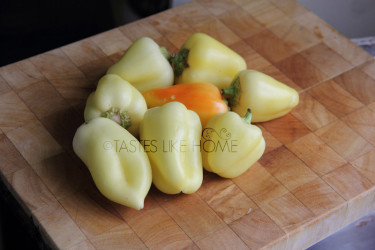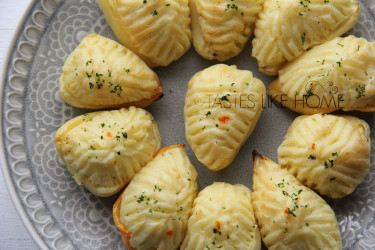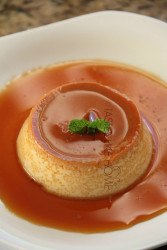In Good Taste recipes this week – one side and one dessert – are not your usual Christmas fare and that’s a good thing. You can only eat so much vegetable rice, mashed potato and fruit cake. These take you a bit outside the box.
Potato-stuffed Peppers
 Peppers, especially the mild and sweet ones are perfect vehicles for stuffing. Their various shapes, colours, and sizes make them appealing and pleasing to the eyes.
Peppers, especially the mild and sweet ones are perfect vehicles for stuffing. Their various shapes, colours, and sizes make them appealing and pleasing to the eyes.
When peppers are stuffed, it is more about the stuffing rather than the taste of the peppers, and they can be stuffed with a lot of things – ground meat, seasoned rice, breadcrumbs, sausage meat, cheese, vegetables, seafood, the possibilities are many. Potatoes in some form always end up on the holiday table and this year, instead of being simply roasted, as a salad or stacked, how about creating garlicky, cheesy mashed potatoes and stuffing mild/sweet peppers? The presentation is bound to take the blah away from mashed potatoes. Think of these potato-stuffed peppers as elegant food.
Use whatever mild or sweet peppers you can find. I used some Spanish peppers that I found the other day while grocery shopping.
There are no exacting measurements for this ‘recipe’ so I am only going to list the items, make as many as you like.

(Photo by Cynthia Nelson)

(Photo by Cynthia Nelson)
INGREDIENTS
- Mild or sweet peppers
- English potatoes boiled in salted water
- Salted or unsalted butter
- Ground white or black pepper
- Whole milk
- Grated sharp cheddar cheese
- Roasted garlic
- Pepper sauce
DIRECTIONS
- Preheat oven to 375 degrees F.
- Line a baking sheet with parchment paper and set aside.
- Cut the peppers in half; remove the seeds, stems and membranes. Wipe clean and aside.
- Add the remaining ingredients and mash until smooth (mash while the potatoes are piping hot).
- Stuff the peppers with mashed potatoes. Use the tines of a fork to create a design.
- Assemble on baking sheet; transfer to oven and bake for 25 minutes until golden and the potatoes are puffed up. Cool on a wire rack and serve warm as a side dish.
Crème Caramel
Who doesn’t love good custard with its own sauce? Crème caramel, also known as flan is simply irresistible. The licking of one’s spoon is undeniable, although ‘Miss Manners’ would probably frown on such behaviour.
Some recipes call for use of a combination of whole eggs and yolks but I prefer to use the whole eggs alone. This recipe yields 6 individual crème caramel but to make more, simply double the recipe. What’s great about a dessert like crème caramel/flan is that it can be made 2 to 3 days ahead and be refrigerated until ready to serve.
SPECIAL EQUIPMENT

6 x standard-size ramekins or ovenproof bowls of the same capacity
1 large roasting pan or 1 (9 x 13) baking dish
INGREDIENTS
For caramel:
- ¾ cup of white sugar
- Unsalted butter for greasing ramekins
For custard:
- 5 large eggs
- 1 teaspoon vanilla essence
- 2 ½ tablespoons sugar
- 2 cups whole milk
DIRECTIONS
- Preheat oven to 325 degrees F.
- Boil a kettle of water.
For caramel:
- Spread the sugar in an even layer in a saucepot and place over medium to low heat until the sugar melts and turns amber (deep rich dark copper). Working quickly, pour the caramel into the 6 ramekins. Let cool until the caramel hardens then butter the sides of the ramekins.
- Assemble the ramekins into the baking dish and set aside.
For custard:
- Whisk together all the ingredients until the sugar is dissolved. Pour through a sieve into a large measuring jug or a regular jug with pouring spout.
- Pour the mixture evenly into the ramekins.
- Transfer the baking dish with the filled ramekins to the oven and then pour the hot water into the baking dish (be sure not to get any into the custard) until it comes half way up the sides of the ramekins.
- Bake for 20 – 25 minutes or until the custard is set; there should be no bubbles appearing around the edges (that is a sign that they are overcooked).
- Remove the baking dish from the pan, and using tongs, carefully remove the custards from the pan and set on a wire rack to cool completely. Cover with plastic wrap (it should not touch the caramel) and refrigerate overnight or for at least 6 hours before unmolding and serving.
To serve:
- Loosen the edges of the custard by running a paring (small knife) around the caramel. Place a serving dish on top of the ramekin and turn it upside down, the custard should loosen and plop onto the plate along with the caramel sauce. Garnish with mint (optional).
NOTE
For richness, the whole milk can be replaced with (whole) evaporated milk.




